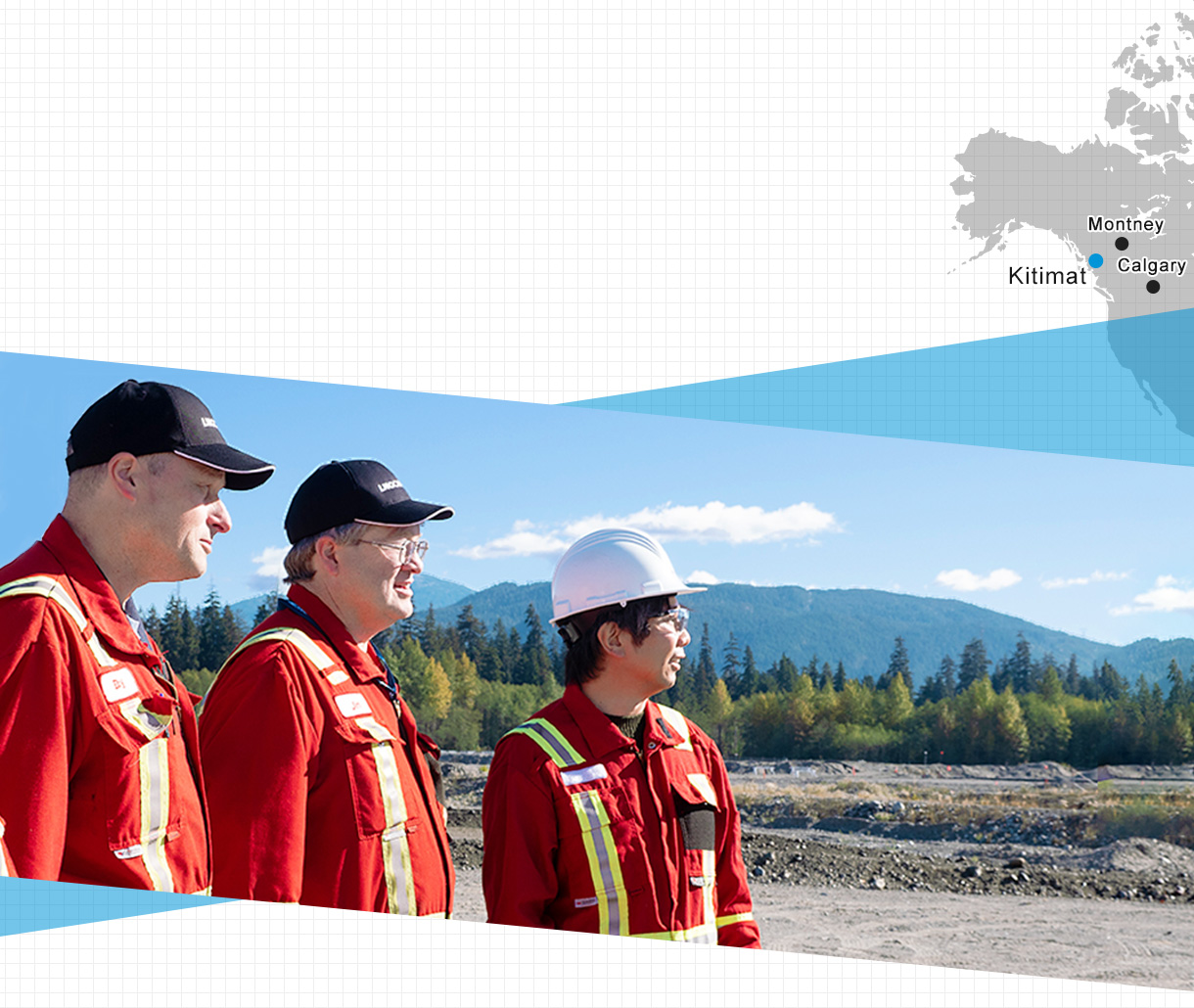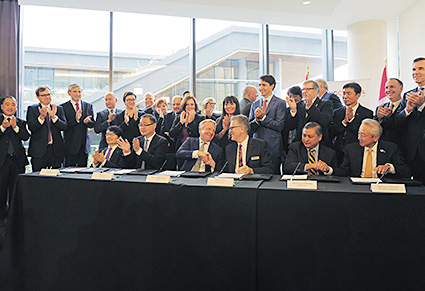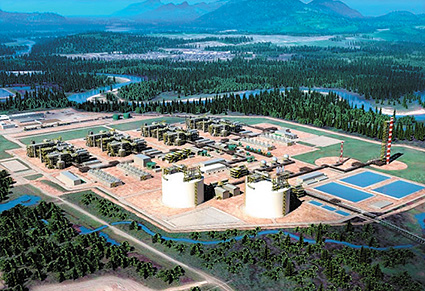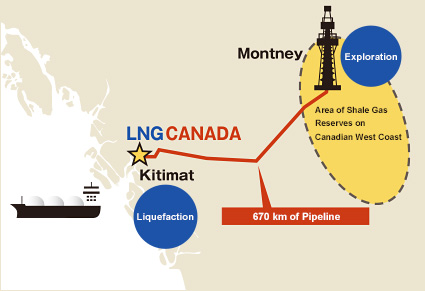Vol.3 LNG Canada Project


Vol.3
LNG Canada Project
Delivering Canadian Shale Gas to Japan
Bridging Two Countries with LNG
This series introduces some of the MC Group's global operations and the people behind them. Our third installment features MC's LNG Canada project. Canada is one of the world's leading producers of shale gas, and this project is a large-scale endeavor to secure a long-term, stable supply of liquefied natural gas (LNG) for Japan and other Asian markets. We interviewed Jin Yamamoto, an MC employee whose challenge is to coordinate the project's multi-national, five-company joint venture and play a leading role in the development of its business.

Canadian Prime Minister Justin Trudeau attends the signing ceremony in Vancouver, BC
Top: Canadian Prime Minister Justin Trudeau attends the signing ceremony in Vancouver, BC
Bottom: MC's LNG development project in Canada
Canada's Largest LNG Export Project Now Up and Running
As countries the world over continue to diversify their energy supplies to help realize sustainable societies, we can expect to see a growing demand for natural gas, which produces comparatively fewer CO2 emissions than other fossil fuels. MC has its sights on Canadian shale as a new source of natural gas, and this past autumn the trading company leveraged its approximately 50 years of experience in the LNG trade to set its Canada project into full swing.
On October 2nd, MC, Shell and the state-run energy companies of Malaysia, China and Korea announced that they had reached the final investment decision (FID) on their joint venture LNG Canada. The new company will build an LNG plant with an annual production capacity of 14 million tons in Kitimat British Columbia (BC), which is situated on the Canadian west coast. The aim is for LNG Canada to begin exporting LNG to Japan and other parts of Asia by the mid 2020s.
MC will transport natural gas (feed gas) extracted from the Montney project in BC's interior via pipeline to the plant, where it will be processed into LNG for export to Japan. Yamamoto was seconded to LNG Canada's upper-management team.
After joining MC, Yamamoto spent six years in the LNG business, where he was involved in upstream-to-downstream operations spanning everything from the dispatch of LNG carriers and brokerage of sales contracts, to the identification of new customers and development of mineral exploration projects. Although he left the company briefly, his desire to use his experience in the LNG business to help enrich societies convinced him to come back, and in February 2017 he was assigned to LNG Canada's headquarters in Calgary, Alberta.

Artist's conception of completed LNG processing plant

Face-to-face communication is vital to success
Top: Artist's conception of completed LNG processing plant
Bottom: Face-to-face communication is vital to success
Bridging a Multinational Management Team as Japan's Only Representative
The year before Yamamoto was assigned to LNG Canada, a drop in the oil price and other setbacks had actually put the FID on hold. However, the project was just as important to Canada as it was to its Asian interests, considering how the Shale Gas Revolution had caused a drop in Canada's US-bound energy exports and the Canadians were eager to secure new markets for their oil and gas. Thanks to the support of the Canadian government and local residents, as well as the expected long-term profitability of the project due to growing demand for LNG, the FID was finally reached last autumn.
With limited manpower, Yamamoto had been working day and night conducting surveys, preparing materials and acting as project coordinator for LNG Canada's five shareholders. So when he learned that the FID had been made, he was both relieved and delighted. "We are finally at the start line," he beams. "Construction of the plant can now get underway, and from this point on it will be make or break for us. I am going to have to be on the ball to ensure that our production and export operations start on schedule and budget."
Yamamoto's position demands that he get a team of veteran pros in resource development and plant construction all on the same page and ensuring that the business goes according to plan. "Everyone is scattered in different locations, so it is very difficult to get us all together to discuss things," he says. LNG Canada's offices are located in different parts of the world and separated by function, so to overcome the geographical distances and time differences, Yamamoto has to ensure that communications are swift and keep the project moving forward smoothly. He takes full advantage of email and instant-messaging services and, whenever possible, tries to speak face-to-face with his colleagues, who have noted his knack for being in "several places at once."
"At LNG Canada, we have a saying, 'Care for People,' and it is something I take very seriously," says Yamamoto. "I make myself as available as I can, and I try to read our employees' faces for any signs of concern. I have to pay carefull attention, otherwise I might miss something that could prove costly down the road."
Yamamoto's efforts have not gone unnoticed by project CEO Andy Calitz, who has high praise for his Japanese colleague. "In any joint venture, it is essential that you get all the partners working together in harmony. Teamwork is the key to success, and Jin has proven himself to be indispensible in building a strong relationship between us and getting us to focus on our common goal," he says.
Helping To Develop a New Canadian Industry and Bring Energy Stability to Japan
Since October, the LNG Canada project has really taken off. Construction of the plant is already underway and work to lay the pipeline is making steady progress. In just one month's time, the joint venture's workforce had doubled. Provided that the LNG production lines can be brought on line, for the time being the project should be capable of delivering approximately 2.1 million tons of LNG to Japan per year.
"The purpose of this project is not just to help secure energy for Japan, but also to create a long-term foundation for the BC economy and boost Canadian revenues," says Yamamoto. "We need to make sure that it moves forward without any delays, so sound management is going to be all the more important as the company grows and evolves over time."
Yamamoto attended high school in the US, and when he returned to Japan to go to university, he was determined to strengthen his Japanese identity. He elected to join MC because he wanted to "help Japan and the world through natural resources businesses," and by getting engaged in this project, he has demonstrated his desire to "bridge the countries of Japan and Canada."
"In emerging countries, fossil fuels are still the main sources of energy. Nothing would please me more than if I could help those countries to switch to LNG in the future, because I want this planet of ours to keep getting better." It seems that there are no challenges too great for Jin Yamamoto.
After the Inteview
Following a one-hour drive from the airport that takes us through the beautiful BC woodlands, we arrive at Kitimat, a district municipality of some 8,000 people along BC's northern coast. Many of those residents are involved in the LNG Canada project, and they are in a celebratory mood at our welcome festival. Canadian infrastructure projects require the understanding and support of its First Nations' leaders, and for Yamamoto, the following message delivered by the local chief at the project's press conference are a great source of encouragement: "On behalf of our children, grandchildren and great-grandchildren, I thank you." No doubt Yamamoto is now thinking to the future, to the day when Canadian LNG will serve as a lifeline for the people of Japan.
From the December 12, 2018 edition of The NIKKEI, Advertising




